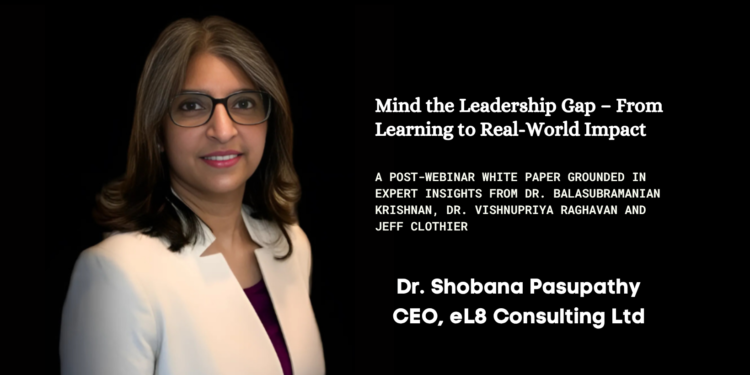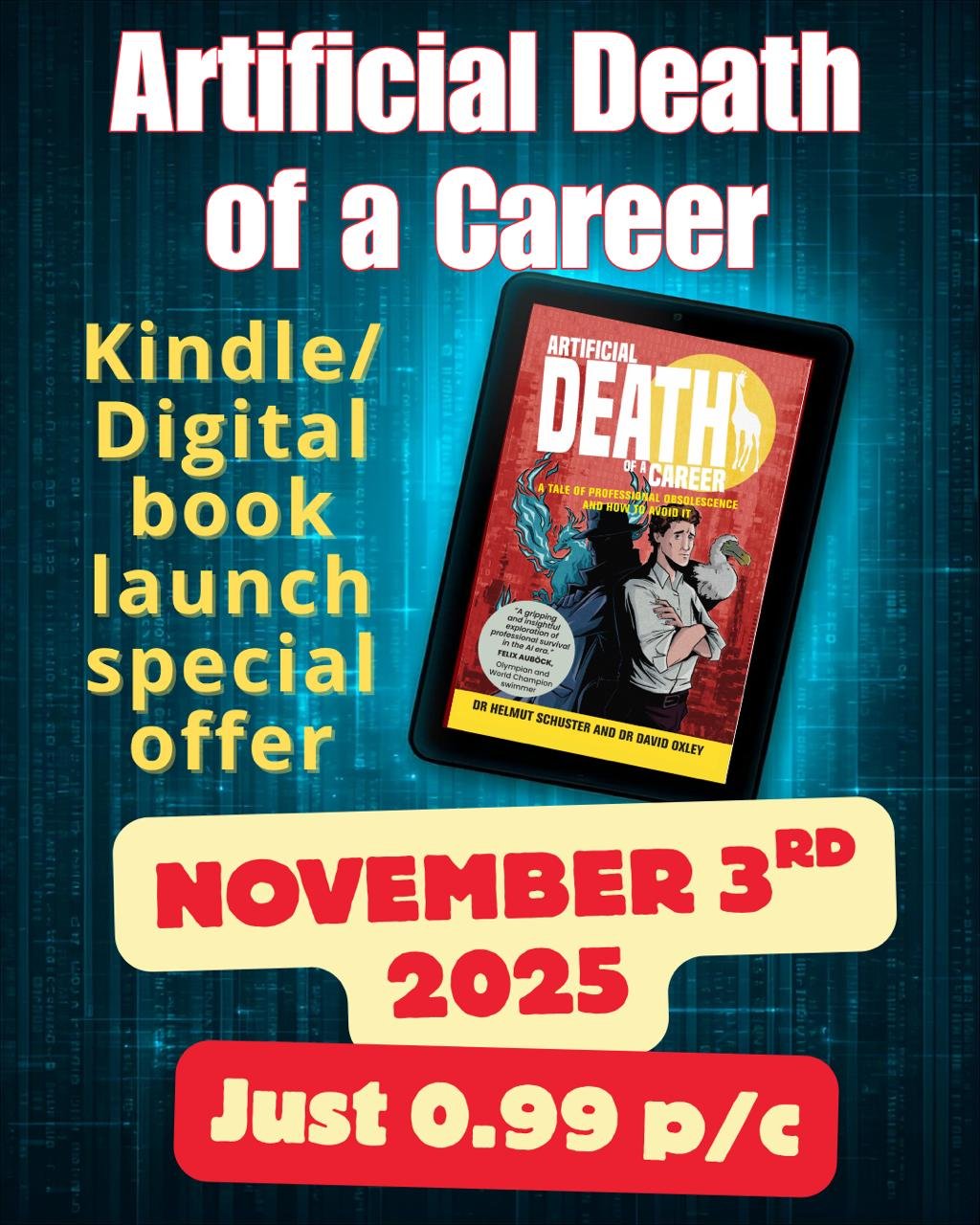A post-webinar white paper grounded in expert insights from Dr. Balasubramanian Krishnan, Dr. Vishnupriya Raghavan and Jeff Clothier
Abstract
Traditional leadership development programs focus heavily on learning adoption—completion metrics, participant satisfaction surveys, and content consumption. But these metrics don’t guarantee behavior change or business impact. This gap results in wasted investment. Leading research and industry data reveal that only learning transfer—the application of new skills on the job—drives return on investment (ROI) and meaningful performance improvements. This white paper equips L&D leadership with both the mindset shift and tactical blueprint needed to transform learning from consumption to capability. Real business impact is within reach—if we let go of outdated adoption metrics and focus on transfer, accountability, and measurable ROI.
Leadership and L&D professionals will gain actionable insights and roadmaps to move beyond adoption and toward capability building with measurable outcomes.

Executive Summary for Senior Leaders and Investors
Leadership development remains a top investment priority—yet most organizations fail to convert learning into measurable business outcomes. The core issue is not the quality of learning, but the absence of learning transfer: the process by which leaders apply what they’ve learned to real-world performance. Current L&D metrics (completion rates, satisfaction scores, assessments) offer limited insight into the actual impact. Less than 12% of organizations can reliably measure ROI.
This article reframes leadership development through the lens of performance and value creation. It distinguishes between traditional learning metrics and business impact measures like productivity gains, cycle-time reduction, revenue lift, and retention. The lack of transfer is rooted in systemic challenges—resource constraints, fragmented program design, and a gap in performance measurement capabilities.
While we argue whether transfer must be a cross-functional responsibility, true transfer requires a shared commitment: L&D to design with transfer in mind, managers to reinforce behavior, business leaders to link learning with strategy, and technology to provide real-time nudges and data. Emerging AI tools and adaptive systems now make personalized, scalable learning transfer achievable at a fraction of traditional costs.
Ultimately, without learning transfer, there is no ROI. The future of L&D lies not in what is taught—but in what is applied, reinforced, and measured.

1. What L&D Is Measuring—and What They’re Missing
Across organizations, L&D teams track learning through consumption and satisfaction metrics—such as course completions, NPS scores, and time spent learning. These are easy to capture but are dangerously misleading if used as proxies for impact. Also, they rarely answer the critical question: did the learning result in better performance? A 2024 Bridge LMS report revealed that only 33% of organizations attempt to track learning transfer or ROI, and fewer than 12% do so effectively. This highlights a systemic problem—L&D measures what’s easy, not what truly drives impact.
Vishnupriya emphasized this distinction:
“We measure attendance and completion. But what we need is to capture psychological, convictional, and behavioral changes. That’s where the real shift happens.”
Only 12% of L&D functions can effectively measure business ROI of their programs (McKinsey, 2023), and just 33% track learning transfer (Brandon Hall Group, 2022). This reliance on vanity metrics masks the bigger issue: skills and behaviors aren’t translating into performance improvements.
2. Measuring Business Impact vs. Learning Impact
L&D must evolve beyond traditional learning metrics to measure business impact—where it counts. Learning impact tells you if someone enjoyed the session or passed a quiz; business impact shows if they now lead better, sell more, or solve faster. Stakeholders expect this clarity—96% want impact data, 74% want ROI. Yet L&D stops short, rarely connecting learning outcomes to real KPIs like retention, revenue, or customer satisfaction. That’s the gap—knowing learners changed, not just learned. To close the gap, we must distinguish:
| Learning Impact | Business Impact |
| Pre/post assessments, quiz scores | Improvement in role-specific KPIs |
| Learner satisfaction (Level 1 feedback) | Increased productivity, reduced attrition, NPS |
| Completion rates | Faster project cycles, higher deal conversions |
Vishnupriya framed this gap succinctly:
“Learning providers can only measure up to a point—true business impact lies in faster solutioning, revenue shifts, client engagement, and leadership legacy. That needs to be measured by the business.”
3. Why L&D Doesn’t Invest Enough in Learning Transfer
Despite knowing the value of learning transfer, most L&D teams don’t invest enough in it. Why? The answer is – Time and budget. These limitations affect teams and embedding transfer strategies requires cross-functional alignment they often lack. Even when there’s willingness, capability is scarce—only a third of professionals are trained in evaluation design or behavioral measurement. Most critically, programs are still built in silos. Without integrating learning into workflows, transfer efforts are reduced to one-off sessions with limited longevity.
- Budget and Capacity Constraints: 66% of L&D leaders report[1] underfunding and lack of dedicated resources for follow-through.
- Siloed Mindsets: Learning is still viewed as a one-off “event” rather than a continuous performance strategy.
- Short-Term Expectations: Business sponsors often lose patience before behavioral change kicks in, especially in complex leadership programs.
Jeff Clothier shared:
“Momentum often fizzles after 30 or 90 days. Because business needs evolve, and the learning wasn’t embedded in the workflow. It’s natural—but it’s also avoidable if we design for continuity.”
4. Who Owns Learning Transfer?
One powerful insight from the webinar: learning transfer isn’t L&D’s sole responsibility. It requires a shared ownership mode. Transfer is a team sport—it cannot rest solely on L&D’s shoulders. L&D must build learning with transfer in mind: embedding application, job aids, and behavior metrics. Managers must reinforce learning on the ground through coaching, feedback, and accountability. Business leaders align programs to strategic priorities and ensure ownership. Technology—LMS, LXPs, AI nudges—offers continuity. Transfer only happens when all these actors coordinate. It fails when L&D tries to “own” what must be shared across the system.
| Stakeholder | Role in Learning Transfer |
| L&D Teams | Architects experience design; measure learning effectiveness; enable follow-through |
| People Managers | Reinforce behaviors on the job; create accountability; model learned behaviors |
| Business Leaders | Define strategic learning outcomes; prioritize capability over content |
| Learners | Reflect, apply, and personalize their learning experience |
Shobana noted:
“We must flip the script. Don’t start with the learning design. Start with business metrics—and then backsolve behavior and impact that’s needed.”
5. What It Means to Design Beyond the Classroom
True learning ecosystems stretch far beyond the classroom. Before learning, align with business units, gather baseline KPIs, and prep managers to reinforce learning. During learning, use active methods—real-world simulations, decision games, and peer challenges. Post-learning, activate follow-through via project work, check-ins, and dashboards. Deloitte’s research[2] shows embedding learning into daily work drives 3x better performance alignment. Transfer thrives not through content delivery—but through continuity, context, and constant reinforcement within real work environments. Designing beyond the classroom isn’t about more content—it’s about designing ecosystems that drive application. It requires a before-during-after architecture:
- Before: Align on business KPIs. Build learner curiosity. Engage managers.
- During: Use simulations, live case projects, and reflection time. Facilitate peer feedback and coaching.
- After: Reinforce learning through nudges, mentoring, spaced repetition, and project execution.
Jeff highlighted:
“The real learning happens when people can reflect. We built a learning ecosystem that housed not just learning, but documents, SOPs, videos—everything searchable, contextual, and user-driven.”
6. Where Does L&D’s Responsibility End?
This was one of the most debated questions in the webinar. L&D’s job doesn’t end at learning delivery—it ends when behavior changes. Their role is to create the infrastructure: performance aids, digital workflows, and feedback tools that make transfer possible. But L&D teams can’t own the full journey. Sustained application rests with business managers who coach, observe, and reward new behaviors. L&D enables transfer, equips others, and measures progress—but the frontline application lives in business, not in learning departments. Transfer is driven by systems, not sessions.
- L&D can influence mindset, build ecosystems, and track behavior.
- But only the business can drive application and accountability.
Vishnupriya explained:
“A great teacher or coach can only do so much. Growth happens only when there’s a learning appetite. Learners must seek feedback, reflect, and act. That’s outside the scope of any classroom.”
7. How AI and Technology Can Enable Learning Transfer at Scale
AI and digital tools are revolutionizing transfer—cost-effectively and at scale. AI coaching bots mirror human coaches for specific tasks, offering timely nudges and structured reflection. Adaptive learning engines tailor content to real-time needs, while personalized AI tutors drive mastery through spaced repetition. Embedded analytics and micro-nudges keep learning alive at work. Studies show hybrid human–AI coaching models are cost-effective —with strong ROI in performance and engagement[3]. Transfer is no longer costly, it’s scalable. The opportunity to build cost-effective, high-touch learning transfer systems using AI is more real than ever:
- Learning Application Bots: Tools like Nuveda’s “Learning Application Bot” help assess on-the-job behavioral shifts over time.
- AI-Powered Reflection Prompts: GenAI tools that encourage learners to document what they applied—and what didn’t work.
- Peer Benchmarks & Micro-Metrics: AI can compare cohorts’ progress and automatically recommend reinforcement content.
Krishnan analogized:
“Leadership capabilities are like black holes—you shine light and infer what’s happening by what comes back.” That’s where structured reflection, feedback loops, and AI nudges come into play.
8. Critical Questions L&D Leaders Must Ask Themselves
As the webinar revealed, this isn’t about designing better learning events—it’s about designing better performance ecosystems. The real shift lies in asking:
- Are your programs tied directly to business KPIs, or floating in isolation?
- Are our leadership programs cultivating leadership or just educating leaders?
- Do we design for learning application —or content delivery?
- Have we made learners and managers co-owners of application?
- Are we prepared to use AI to coach and guide—at scale, not just through humans?
Learning without transfer is like strategy without execution—intellectually satisfying, but operationally meaningless. It’s not enough to teach. We must ensure people use what they learn. That’s where the value lies.
About the Panelists
Jeff Clothier is an innovative and engaging educational facilitator with experience creating and delivering customized training solutions (eLearning and instructor-led courses) to optimize organizational performance. Recognized for coordinating large-scale training projects and new course implementation for employees across the globe. Build and strengthen relationships with key stakeholders, senior leaders, and employees. Master Certified Instructor in Social Style and Designated Master Instructor by Association for Talent Development.
Dr. Vishnupriya Raghavan brings over 25 years of diverse experience across technology, business and consulting, Dr. Vishnupriya Raghavan serves as Vice President – Client Advisory and Transformation at StackRoute, NIIT Limited. In this role, she leads the design and delivery of customized learning interventions focused on technology and technology leadership, working with clients across India and globally to shape future-ready talent and drive strategic transformation.
At the forefront of large-scale transformation initiatives, Dr. Vishnupriya specializes in crafting bespoke programs that address the unique challenges and aspirations of technology-driven organizations. Her work is deeply rooted in building leadership and capability development solutions that are contextual, high-impact/, and aligned with business objectives.
She holds a Master’s degree in Mathematics and a PhD in Information Systems. She has authored 15 publications in leading academic and industry journals, covering emerging areas such as Artificial Intelligence, Blockchain, UX/UI, and Industry 4.0.
Dr. Balasubramanian Krishnan is a proven global executive and seasoned entrepreneur with 30+ years’ experience leading and managing teams across large and small companies. Proven Change Management and Innovation expertise driving Sigma and Operational Excellence across large corporations. Business Development expertise with an eye for accelerated growth through partnerships. Learning Technologist with experience providing learning solutions that involve design, delivery, and service of e-learning systems, technologies and processes. Learning professional with experience designing and delivering leadership programs, six sigma and innovation offerings over multiple formats – instructor-led, blended, simulations and e-learning. Key Architect of NuVeda’s learning measurement technology platform, NuCLO(TM). Executive Coach with a passion for recognizing and growing talent.
Co-founder and CEO, NuVeda LLC, Minneapolis, USA and NuVeda Learning Pvt. Ltd, Chennai, India.
Hands on experience selling, designing, and delivering e-learning solutions including LMS systems, e-learning content, instructional design and authoring tools. Trademarked “FLFLCL” – Facilitator-led Fun Learning for Continuous Learning.
Experience as a keynote speaker and Panelist. US Patent Holder.
Author of “The Google of Learning” – an innovative approach to learning technologies 10-20 years into the future; Author of the blog: http://www.nuvedalearning.com/blog; Co-authored approximately a dozen scientific papers in physics.
References
[1] https://tier1performance.com/wp-content/uploads/2023/04/2023-Learning-Trends-Report.pdf?utm_source=chatgpt.com
[2] https://www.trainingjournal.com/2025/audience_role/experienced_landd/re-thinking-roi-how-to-secure-learning-and-developments-seat-at-the-table/?utm_source=chatgpt.com
[3] https://elearningindustry.com/no-code-and-ai-how-ld-teams-are-building-self-learning-training-ecosystems?utm_source=chatgpt.com
Read Also : HR Is Not a Support Function—It’s the CEO’s Most Powerful Growth Engine
The Fine Balance: Navigating Work, Life, and Mental Wellbeing
From Gatekeeping to Gateway Building: Transforming How Organisations Create Access
Leadership In Talent Management: A Powerful Driver for Economic Growth











